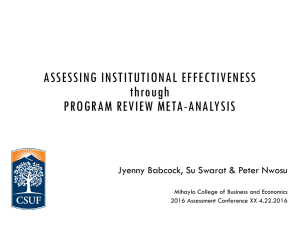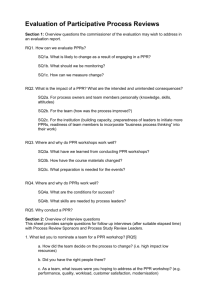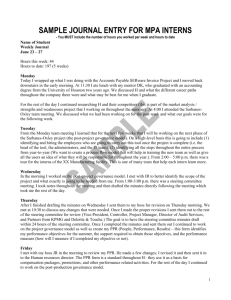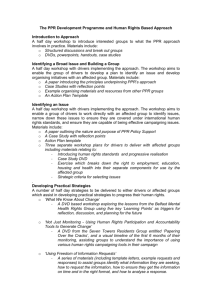Task Static Single Assignment (T-SSA) and (short paper)
advertisement
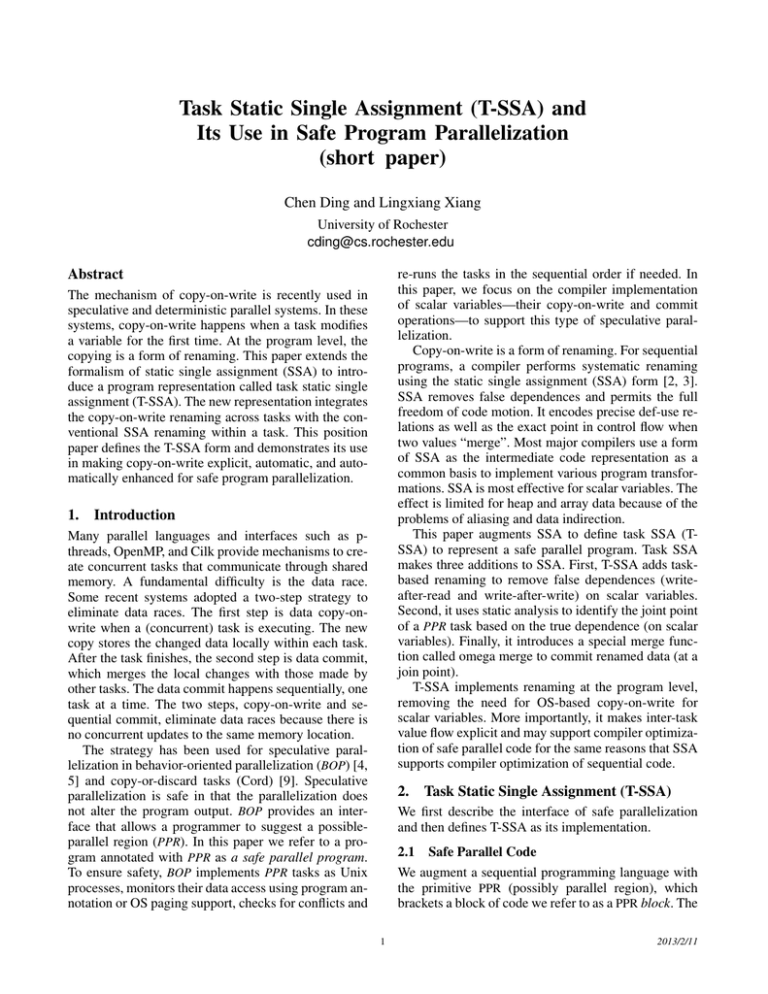
Task Static Single Assignment (T-SSA) and
Its Use in Safe Program Parallelization
(short paper)
Chen Ding and Lingxiang Xiang
University of Rochester
cding@cs.rochester.edu
Abstract
re-runs the tasks in the sequential order if needed. In
this paper, we focus on the compiler implementation
of scalar variables—their copy-on-write and commit
operations—to support this type of speculative parallelization.
Copy-on-write is a form of renaming. For sequential
programs, a compiler performs systematic renaming
using the static single assignment (SSA) form [2, 3].
SSA removes false dependences and permits the full
freedom of code motion. It encodes precise def-use relations as well as the exact point in control flow when
two values “merge”. Most major compilers use a form
of SSA as the intermediate code representation as a
common basis to implement various program transformations. SSA is most effective for scalar variables. The
effect is limited for heap and array data because of the
problems of aliasing and data indirection.
This paper augments SSA to define task SSA (TSSA) to represent a safe parallel program. Task SSA
makes three additions to SSA. First, T-SSA adds taskbased renaming to remove false dependences (writeafter-read and write-after-write) on scalar variables.
Second, it uses static analysis to identify the joint point
of a PPR task based on the true dependence (on scalar
variables). Finally, it introduces a special merge function called omega merge to commit renamed data (at a
join point).
T-SSA implements renaming at the program level,
removing the need for OS-based copy-on-write for
scalar variables. More importantly, it makes inter-task
value flow explicit and may support compiler optimization of safe parallel code for the same reasons that SSA
supports compiler optimization of sequential code.
The mechanism of copy-on-write is recently used in
speculative and deterministic parallel systems. In these
systems, copy-on-write happens when a task modifies
a variable for the first time. At the program level, the
copying is a form of renaming. This paper extends the
formalism of static single assignment (SSA) to introduce a program representation called task static single
assignment (T-SSA). The new representation integrates
the copy-on-write renaming across tasks with the conventional SSA renaming within a task. This position
paper defines the T-SSA form and demonstrates its use
in making copy-on-write explicit, automatic, and automatically enhanced for safe program parallelization.
1.
Introduction
Many parallel languages and interfaces such as pthreads, OpenMP, and Cilk provide mechanisms to create concurrent tasks that communicate through shared
memory. A fundamental difficulty is the data race.
Some recent systems adopted a two-step strategy to
eliminate data races. The first step is data copy-onwrite when a (concurrent) task is executing. The new
copy stores the changed data locally within each task.
After the task finishes, the second step is data commit,
which merges the local changes with those made by
other tasks. The data commit happens sequentially, one
task at a time. The two steps, copy-on-write and sequential commit, eliminate data races because there is
no concurrent updates to the same memory location.
The strategy has been used for speculative parallelization in behavior-oriented parallelization (BOP) [4,
5] and copy-or-discard tasks (Cord) [9]. Speculative
parallelization is safe in that the parallelization does
not alter the program output. BOP provides an interface that allows a programmer to suggest a possibleparallel region (PPR). In this paper we refer to a program annotated with PPR as a safe parallel program.
To ensure safety, BOP implements PPR tasks as Unix
processes, monitors their data access using program annotation or OS paging support, checks for conflicts and
2.
Task Static Single Assignment (T-SSA)
We first describe the interface of safe parallelization
and then defines T-SSA as its implementation.
2.1 Safe Parallel Code
We augment a sequential programming language with
the primitive PPR (possibly parallel region), which
brackets a block of code we refer to as a PPR block. The
1
2013/2/11
annotation suggests parallelism between the PPR block
and its subsequent code. A suggestion does not change
semantics—the execution with suggestions always produces the same output as the execution without suggestions. A suggestion may be inserted manually by a
user or automatically by a tool. It can express partial
parallelism where a PPR task is parallel in some but
not all executions. A suggestion can be wrong. Operationally, the PPR annotation can be viewed as an optimistic spawn or fork. As a hint, the user is not required
to insert the matching join points for the spawn (although a suggestion can be made through a dependence
hint [5]). In its general form, PPRs may be nested.
The task annotation creates a task language rather
than a parallel language. We define tasks using a canonical, sequential execution. A PPR block is made into a
task each time it is executed. Moreover, the code outside a PPR block is also made into a task. If PPRs do
not overlap, the canonical execution is a series of PPR
and non-PPR tasks. With nested PPRs, the execution is
divided into a tree of tasks, whose linear relationship
can be encoded [7]. In a canonical execution, every instruction belongs to a task with a unique id, and the
task ids have a sequential order. We refer to “earlier”
and “later” tasks by their canonical order. The goal of a
parallel implementation is to maximize the parallelism
between each task and its subsequent execution, that is,
its later tasks.
Listing
1:
PPR code
task {
x = 1
y = x + 2
}
x=3
z =x+y
Listing 2: The T-SSA form
p1 = ppr spawn {
x1,t1 = 1
y1,t1 = x1,t1 + 1
}
x2,t2 = 3
ppr join( p1 )
x3,t3 = ω(x1,t1 , x2,t2 ) = x2,t2
y2,t3 = ω(y1,t1 ) = y1,t1
z1,t3 = x3,t3 + y2,t3
Figure 1: An example safe parallel program and its
task SSA form, which adds the PPR spawn, join, task
subscript, and ω merge.
ing 2, two assignments are run in parallel writing to two
renamed xs. The data race is removed by renaming. After the parallel execution, the surviving x is determined
by the omega merge, which chooses the x from the
second task.
As a parallel form, T-SSA has to go beyond SSA.
First, it provides task-based renaming (in addition to
assignment-based renaming in SSA), so it removes
races and false dependences. Second, it determines
when a task should be joined based on the def-use relation. Third, at the join, it merges T-SSA names based
on the task subscript.
T-SSA is not entirely static in the first and the third
step. The task subscript is dynamic. Still to analyze
it in a compiler, we give static ids assigned differently for each static PPR code block and inter-PPR
code region. In contrast, the φ merge in SSA is static
evaluated entirely at compile time (through SSA deconstruction [2]). In general, the omega merge may be
a dynamic operation. In the 2-task example in Listing 2,
the omega function is statically evaluated, demonstrating a benefit of compiler analysis.
2.2 The T-SSA Form
In the SSA form, variables are renamed so that each
assignment defines a new name, and each use refers
to a single definition [2, 3]. The task SSA extension is
three-fold:
• PPR id and PPR join. Each PPR block has a unique
static id px . The join function PPR join( id ) waits
for all earlier px tasks (before the current task, so px
can “join itself”, i.e. call PPR join( px )).
• Task subscript. Each variable has the task id, t, as
the second subscript (the first being the SSA subscript). The new subscript symbolizes the renaming
in different tasks.
• Omega merge. The omega merge takes a set of renamed versions of a variable and chooses one from
the latest task, i.e. the one with the largest task subscript. The symbol ω comes from the same vernacular as φ in the original SSA, and its shape visually
resembles the merge of parallel sources.
2.3 T-SSA Construction
T-SSA construction follows the 4-step process below. It
is similar to SSA construction [2] except for the middle
two steps of inserting join points, omega merges, and
task subscripts.
1. φ function insertion, same as in SSA construction by
computing the dominance frontiers [2].
2. ω function and task join insertion.
3. renaming variable assignments with the task subscript
4. renaming variable uses through reaching definition
analysis, as in SSA construction [2].
As a simple example, consider the program in Listing 1. Variable x is first assigned in a PPR to compute y
and then assigned again after the PPR to compute z. In
the implementation shown by the T-SSA form in List2
2013/2/11
The runtime uses pthread as backend, mapping an
active task to a running thread. Each thread has its
own local PPR stack, where the variables with intertask dependence are kept (the compiler pass decides the
layout of task stack), so modifications to these variables
are temporarily buffered in local task stack. When a
task thread is joined by a φ function, the dirty part of
its local stack will be merged to a global stack. Since at
a join point, the runtime joins a PPR’s threads in their
creation order, the last modification to a same variable
in the task stack is always visible. In other words, the
sequential semantics of original code is maintained in
its T-SSA equivalence.
The runtime also limits the number of concurrent
threads for a PPR so as not to spawn redundant threads.
In addition, thread pool technique is used to minimize
the overhead of thread creation.
The second step is the most complex part of the TSSA extension. The basic problem is join-point insertion, with the following requirements.
• Safety. For each variable read, use(x), in task t, all
tasks spawned before t containing a def(x) must be
joined before use(x) in t.
• Parallelism. A task should not be forced to join until
one of its results is used by another task.
• Efficiency. A task should not be joined again if it is
already requested by a previous join.
The algorithms are omitted for lack of space. The insertion uses maybe-parallel analysis and solves a dataflow problem in ways similar to methods used in the
compilers for explicitly parallel code (e.g. [1, 8]).
3.
T-SSA based PPR Hint Improvement
5.
T-SSA makes data flow explicit in the parallel code, in
particular the def-use relations within and across PPR
tasks. The information can be analyzed statically to
transform a program to increase its parallelism.
A simple matrix manipulation microbenchmark is used
for preliminary testing of the T-SSA system. For each
row in the matrix, the microbenchmark (Listing 6) first
fills it with random values, then sorts it in order to
find out its medium value, which is compared with a
constant (T HRESHOLD). A boolean array (f lags)
keeps comparison results for all rows.
Moving dependent operations outside a PPR Consider the example in Listing 3. The loop uses a pointer
variable n to iterate through a list of nodes and a
counter variable c to store the node count. Because the
PPR block includes the pointer move and the counter
increment, there is no parallelism since these operations are mutually dependent, as shown by the T-SSA
form in Listing 4.
A compiler can inspect the def-use of n, c, move
their assignments outside the PPR block and enable
the parallelism among the computations on different
nodes. There is no run-time merge (ω is replaced by φ).
Neither there is a join after the loop, so the node count
c can be printed in parallel when the PPR tasks of the
loop are still executing. The resized PPR block is shown
in Listing 5. The inter-task value flow is changed, as
reflected by the T-SSA names.
4.
Preliminary Results
Listing 6: T-SSA microbenchmark
i n t d a t a [N ROW ] [ N COL ] ;
b o o l f l a g s [N ROW ] ;
f o r ( i n t r = 0 ; r < N ROW; r ++) {
task {
r a n d o m f i l l ( row ) ;
s o r t ( row ) ;
i n t medium = d a t a [ r ] [ N COL / 2 ] ;
f l a g s [ r ] = medium < THRESHOLD ;
}
}
The preliminary tests were conducted on a machine
with a dual-core Intel Core2 Duo E4400 CPU and a machine with a quad-core Intel Xeon E5520 CPU. The latter supports hyper-threading, so 8 hardware threads are
available. On both machines, the maximum number of
concurrent threads is limited to the number of hardware
threads. Compared to sequential code, T-SSA code results in 1.90x speedup on Core2 Duo E4400, and 6.33x
speedup on Xeon E5520.
Implementation
The T-SSA system is implemented in two separate
parts, a T-SSA compiler pass in GCC 4.2.2 and a runtime library. The compiler pass takes GIMPLE intermediate representations generated by GCC’s front-end
as input, and transforms all PPR blocks into their TSSA form using the algorithm in Section 2.3. Each PPR
block is replaced by an equivalent anonymous function
so that it can be executed as a thread at runtime. Task
creations, task joins (φ functions), and omega merges
are implemented as corresponding ABI calls to the runtime library.
6.
Related Work
SSA and its use are expounded in the textbook by
Cooper and Torczon [2]. Most prior work on SSA is
concerned with optimizing scalar variables in sequen3
2013/2/11
Listing 3: A loop
n = head
c = 0
while
n 6= n i l
task {
foo ( n )
n = n → nxt
c=c+1
}
end
print c
Listing 4: T-SSA
Listing 5: PPR resizing
n1,t = h e a d
c1,t = 0
while
ppr join(p1 )
n2,t = ω(n1,t , n3,p1 )
c2,t = ω(c1,t , c3,p1 )
n2,t 6= n i l
p1 = ppr spawn {
f o o ( n2,t )
n3,p1 = n2,t → nxt
c3,p1 = c2,t + 1
}
end
p r i n t c2,t
n1,t = h e a d
c1,t = 0
while
n2,t = φ(n1,t , n3,t )
c2,t = φ(c1,t , c3,t )
n2,t 6= n i l
p1 = ppr spawn {
f o o ( n2,t )
}
n3,t = n2,t → nxt
c3,t = c2,t + 1
end
p r i n t c2,t
Figure 2: T-SSA construction and PPR resizing for a while-loop. The original PPR permits no parallelism while the
resized one does.
tial code [2] or arrays in data parallel code [6]. T-SSA
addresses the copying and merging of scalar variables
in task parallel code, which requires maybe-parallel
analysis and new types of program transformations to
improve parallelism and reduce overhead especially in
copying and merging.
The CorD system of speculative parallelization has
addressed similar issues of copying and merging using
compiler analysis [9]. The paper did not mention an
SSA-based formulation. Other types of compiler analysis have been developed to improve parallel or transactional code e.g. in race checking and sandboxing, but
they do not target the particular strategy of copy-onwrite and sequential commit. Moving code across a
task boundary is rarely permitted since it affects the
parallel semantics. T-SSA eliminates the race condition by renaming. Being more restrictive than parallel
semantics, sequential equivalence permits dependencebased automatic transformation, which the new task
SSA form is designed to support.
7.
[2] K. Cooper and L. Torczon. Engineering a Compiler, 2nd
Edition. Morgan Kaufmann, 2010.
[3] R. Cytron, J. Ferrante, B. Rosen, M. Wegman, and
K. Zadeck. Efficiently computing static single assignment form and the control dependence graph. ACM
Trans. on Prog. Lang. and Sys., 13(4):451–490, 1991.
[4] C. Ding, X. Shen, K. Kelsey, C. Tice, R. Huang, and
C. Zhang. Software behavior oriented parallelization. In
Proceedings of PLDI, pages 223–234, 2007.
[5] C. Ke, L. Liu, C. Zhang, T. Bai, B. Jacobs, and C. Ding.
Safe parallel programming using dynamic dependence
hints. In Proceedings of OOPSLA, pages 243–258, 2011.
[6] K. Knobe and V. Sarkar. Array SSA form and its use
in parallelization. In Proceedings of POPL, San Diego,
CA, Jan. 1998.
[7] J. M. Mellor-Crummey. On-the-fly detection of data
races for programs with nested fork-join parallelism. In
Proceedings of the ACM/IEEE conference on Supercomputing, pages 24–33, 1991.
[8] M. M. Strout, B. Kreaseck, and P. D. Hovland. Data-flow
analysis for MPI programs. In Proceedings of ICPP,
pages 175–184, 2006.
[9] C. Tian, M. Feng, V. Nagarajan, and R. Gupta. Copy or
Discard execution model for speculative parallelization
on multicores. In Proceedings of ACM/IEEE MICRO,
pages 330–341, 2008.
Discussion
T-SSA targets only scalar variables and hence does
not fully guarantee safety of a program execution. The
run-time speculation support of conflict checking and
error recovery are still needed for the rest of program
data [4, 5].
References
[1] S. Agarwal, R. Barik, V. Sarkar, and R. K. Shyamasundar. May-happen-in-parallel analysis of X10 programs.
In Proceedings of PPOPP, pages 183–193, 2007.
4
2013/2/11
